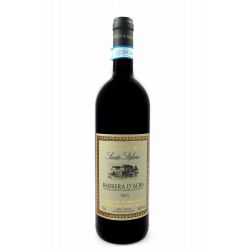- -6%
- Not availables






Castello di Neive and its 150 acre estate are owned by the Stupino brothers and sisters Anna, Giulio, Italo e Piera. They were all born in Neive, and so were their parents, grandparents and great-grandparents.The history of the company began when their father, Giacomo, started to capitalize on both his experience as a surveyor and on his knowledge of the area, and to purchase, whenever possible, vineyards and land in extremely favourable locations. In the small cellars of their home, they began the first production of wine for domestic consumption and to sell in bulk.Messoirano, Montebertotto, Basarin, Valtorta, I Cortini;: the number of vineyards acquired by Giacomo grew and with it also the production and the ambitions of the family. In 1964 they purchased the castle with its spacious cellars, with more farmsteads in Santo Stefano and Marcorino, plus more land from the castle's previous owner, Count Guido Riccardi Candiani.
This is was a turning point which urged the family to renovate the castle's cellars, to reorganize the vineyards neglected by the previous owners and to produce wine according to modern methods. When Giacomo died, in 1970, Giulio end Italo oversaw the transition from tenant farming to direct management of the land, with the precious help of Talin Brunettini, skilful cellar man with a knowledge in agronomic techniques. It is at this time that Castello di Neive began to bottle its wines and to introduce them to the rest of Italy and abroad.
In 1978 another rewarding step: thanks to the collaboration between Italo and some experts from the University of Turin professors Italo Eynard and Annibale Gandini Castello di Neive started a clonal selection programme of Arneis, a grape long forgotten and abandoned because of its scarce productivity and lack of knowledge in white wine vinification. Arneis wine owes its rediscovery to this joint effort by the company and the University. In the past few years, Italo has devoted himself fully to the direct management of the company, under the name Castello di Neive Azienda Agricola: a devotion which seems to follow a 'premonition' contained in an old photograph: one depicting Mentor, Italo's grandfather, presenting a grapevine to his young nephew.
VINEYARD
Castello di Neive comprises a 150 acres (60 hectares) estate, all in the Neive town council, in the Langhe area of the Piedmont region. Sixty-two acres (25 hectares) of the property are devoted to grape growing and all the production, which amounts to an average of 12.000 cases a year, is obtained from Castello di Neive's own vineyards
CELLAR
As I mentioned when introducing the castle, the cellars are extremely large, clearly showing the designers' intention to obtain the best possible options for wine production. They are built on different levels and follow the conformation of the underlying hill. The upper level cellar has vaults approximately 3.5 - 4 metres high, and is used for ageing wine in 35-hectolitre Allier oak barrels, and for storing wines that are ready for delivery. This cellar has a very interesting annex: an 'infernotto' (traditionally the deepest part of the cellars) passing under the hill and the Neive houses, stretching for around 33 metres. This was the old larder, and in winter, snow was gathered here to preserve fresh and cured meats, eggs, cheese, and bottles of Nebbiolo wine. At that time, in fact, prior to the arrival of wine expert Louis Oudart, Nebbiolo was a sweet, sparkling wine, and therefore unstable in the warmer seasons. In this somewhat 'specialist' cellar, the temperature remains stable for most of the year, changing very little, making it the perfect choice for the delicate in-bottle fermentation of the Spumante Metodo Classico. Pinot nero vines were thus planted, and production began with the harvest of 1995. On the lower level we can see a courtyard, preserving a large rare steelyard and wine press, and this is where grapes are taken and production begins. The steelyard was used to weigh the grapes and wine carts as they entered and left. The press has an original, technically advanced bar pull system, with a monolithic stone base that was used right up until the birth of the Vaslin press and subsequently the Bucker press. This two antiques were installed by the wine expert Louis Oudart during the period he spent as a consultant to the Counts of Castelborgo. On this level, the cellar stands about 4.5 metres high a significant feat at the time of its construction. Here we have the fermentation and treatment plants for red and white wine, with automatic temperature control and racking systems. There are also other rooms on this level, in which temperature control allows us to monitor malolactic fermentation, although we also use them as barrique cellars and to age wine in the 33-hectolitre Allier oak barrels. In 1996, whilst replacing the cement baths that had been built there with a rather more modern wine-making plant and automatic racking system, we discovered a second 'infernotto' dug into the tuff stone and probably used as a stable for small animals, sheep and goats - part of the complex on which the castle was built in 1700. The room had been closed off with a wall to prevent unpleasant odours from entering the cellar. And closed it remained... for 300 years
Data sheet
You might also like